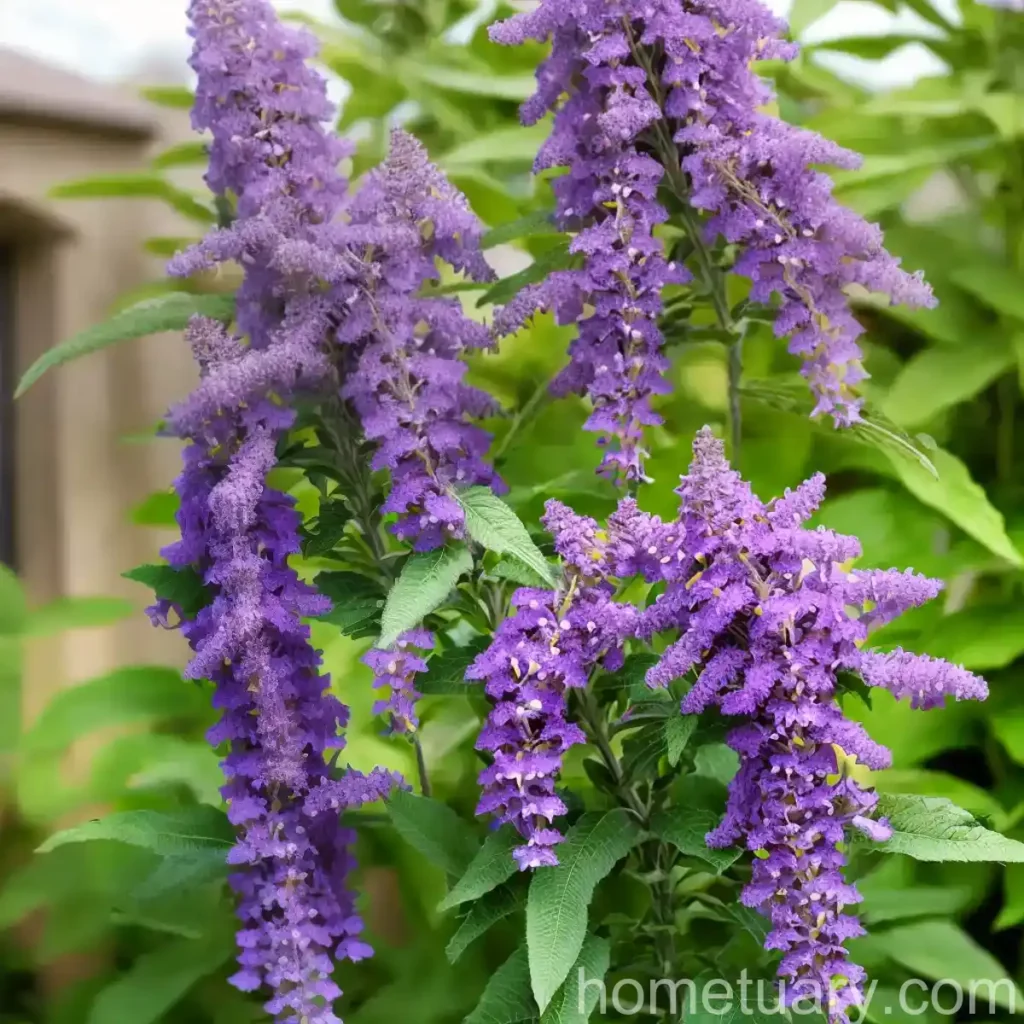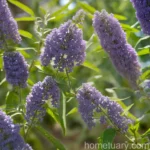Butterfly Bush (Buddleja ‘Miss Violet’)
As a plant scientist, I am delighted to talk about one of the most fascinating and visually stunning plants – the butterfly bush, specifically the Buddleja ‘Miss Violet’ variety. This species is known for its beautiful flowers, which attract a variety of pollinators, particularly butterflies. In this comprehensive guide, I will provide an in-depth overview of the butterfly bush, including various aspects of its culture, uses, care, and maintenance.
What is Butterfly Bush?
The butterfly bush, scientifically known as Buddleja davidii, is a deciduous shrub that belongs to the family Scrophulariaceae. Native to China and Japan, this plant is widely cultivated and appreciated for its architectural form and brilliantly colored, nectar-rich flowers. The cultivar ‘Miss Violet’ specifically is a popular variety that is cherished for its vibrant purple blossoms.
Key Takeaways – butterfly bush (Buddleja ‘Miss Violet’)
Here are the key takeaways for the Buddleja ‘Miss Violet’ variety:
- Scientific Name: Buddleja davidii ‘Miss Violet’
- Common Name: Butterfly Bush
- Flower Color: Vibrant violet/purple
- Attracts: Butterflies and other pollinators
- Growth Habit: Deciduous shrub
- Cultivation: Widely popular in gardens and landscapes
Now, let’s delve into the various aspects that define the culture, uses, and care of the butterfly bush.
Culture
Water
Butterfly bushes, including the Buddleja ‘Miss Violet’ variety, require moderate watering. It is essential to keep the soil evenly moist, especially during the plant’s establishment period. Once established, they demonstrate considerable drought tolerance, although regular watering is still beneficial for optimal growth and flowering.
Sunlight
Full sunlight is crucial for the healthy development of butterfly bushes. These plants thrive in locations with ample sunlight and well-drained soil. They generally require at least 6-8 hours of direct sunlight each day to bloom prolifically and maintain a robust growth habit.
Fertilizer
When it comes to fertilization, butterfly bushes benefit from a balanced, slow-release fertilizer. Applying a general-purpose fertilizer in early spring, just before new growth begins, can provide the necessary nutrients for healthy plant development and abundant flowering. However, it is important to avoid excessive fertilization, as this can lead to excessive vegetative growth at the expense of flower production.
Soil
Butterfly bushes prefer well-drained, loamy soil with good fertility. They are adaptable to a wide range of soil types, but they perform best in soils with a slightly acidic to neutral pH. Amending the soil with organic matter can improve its structure and moisture retention, which is particularly beneficial in areas with sandy or heavy clay soils.
Pruning
Pruning is an important aspect of butterfly bush maintenance, as it helps control the size and shape of the plant, promotes vigorous growth, and encourages the production of new flowering wood. For the Buddleja ‘Miss Violet’ variety and other butterfly bush cultivars, the following pruning guidelines are recommended:
-
Spring Pruning: In late winter or early spring, before new growth emerges, prune the plant back to a height of 12-18 inches from the ground. This encourages the development of strong, new shoots and enhances the overall appearance of the plant.
-
Deadheading: Throughout the growing season, regularly remove spent flowers to prolong the bloom period and prevent the formation of seeds. This practice, known as deadheading, redirects the plant’s energy towards producing more flowers, resulting in a longer and more prolific blooming display.
Propagation
Butterfly bushes can be propagated from both seeds and cuttings. While growing the Buddleja ‘Miss Violet’ variety from seeds is possible, it is more commonly propagated from softwood or hardwood cuttings. Softwood cuttings are typically taken in early summer when the plant is actively growing, while hardwood cuttings are collected in late fall or early winter when the plant is dormant.
Container Popularity
Butterfly bushes are well-suited for container cultivation, making them popular choices for patio gardens, urban landscapes, and small outdoor spaces. When grown in containers, the Buddleja ‘Miss Violet’ variety adds an element of color and attraction to balconies, decks, and other confined areas, while also providing a valuable food source for butterflies and other pollinators.
Common Diseases
Butterfly bushes, including the ‘Miss Violet’ variety, are relatively resilient and not highly susceptible to serious disease issues. However, certain environmental conditions or cultural practices can predispose them to specific ailments. Some common diseases that may affect butterfly bushes include:
- Powdery Mildew: This fungal disease appears as a powdery white coating on the plant’s leaves, often in humid or poorly ventilated conditions.
- Botrytis Blight: Also known as gray mold, this fungal infection causes brown spots and wilting on the plant’s foliage and flowers, particularly common in cool, moist conditions.
- Leaf Spot: Various fungal pathogens can cause circular, brown spots on the leaves, potentially leading to defoliation if severe.
Disease Diagnosis
Diagnosing and addressing potential diseases in butterfly bushes involves careful observation of the plant’s symptoms, as well as an understanding of the prevailing environmental conditions and cultural practices. Regular monitoring for signs of fungal growth, leaf discoloration, or abnormal wilting can help identify any potential disease issues at an early stage. Proper site selection, good air circulation, and general plant health maintenance are essential for preventing disease development.
Common Pests
Butterfly bushes are generally resistant to most pests, but they can occasionally be affected by certain insect problems. The following are some of the common pests that may impact these plants:
- Aphids: These small, soft-bodied insects feed on the plant’s sap, causing stunted growth and distorted foliage.
- Spider Mites: These tiny pests can form webbing on the undersides of leaves and cause stippling and yellowing of the foliage.
- Caterpillars: While butterfly bush caterpillars are a natural part of the plant’s ecological interaction with butterflies, certain caterpillar species can cause extensive defoliation if their populations are not kept in check.
Botanist’s Tips
As a plant scientist, I recommend the following tips for successfully growing and caring for the Buddleja ‘Miss Violet’ variety:
-
Butterfly Attraction: Planting butterfly bushes alongside other nectar-rich flowering plants can create a diverse and attractive habitat for butterflies, providing them with ample food sources and shelter.
-
Pruning Frequency: Regular and strategic pruning is essential for maintaining the butterfly bush’s shape, managing its size, and promoting vigorous flowering. Early spring pruning and consistent deadheading are key practices for achieving an impressive display of blooms.
-
Disease Prevention: Ensuring proper air circulation, avoiding overcrowding of plants, and monitoring for any signs of disease or pest activity can significantly minimize the risk of potential issues in butterfly bushes.
Fun Facts
Here are some fascinating and fun facts about the Buddleja ‘Miss Violet’ variety and butterfly bushes in general:
- The butterfly bush’s attractive flowers not only draw in butterflies but also appeal to hummingbirds and various other beneficial pollinators.
- Butterfly bushes are known for their sweet, honey-like fragrance, which adds a delightful sensory element to garden landscapes.
- The cultivar ‘Miss Violet’ exhibits a compact and rounded growth habit, making it an excellent choice for smaller gardens and container plantings.
- Butterfly bushes are not only visually appealing but also contribute to the ecological balance by supporting local butterfly populations and enhancing biodiversity.
Links to External Resources
For further information on butterfly bush cultivation, care, and utilization, I recommend exploring the following external resources:
- Royal Horticultural Society – Growing Buddleja
- Missouri Botanical Garden – Buddleja davidii
- The Butterfly Site – Butterfly Bushes
- University of California Integrated Pest Management – Butterfly Bush
In conclusion, the butterfly bush, particularly the Buddleja ‘Miss Violet’ variety, is a remarkable plant that significantly contributes to the ecological balance while enhancing the aesthetic appeal of gardens and landscapes. Its vibrant flowers, butterfly-attracting properties, and versatile cultivation options make it a valuable addition to any horticultural setting.
By understanding the cultural requirements, disease and pest management, and the significant role of butterfly bushes in supporting pollinators, gardeners can effectively incorporate these plants into their outdoor spaces, fostering a healthy and vibrant ecosystem.
I hope this comprehensive guide provides valuable insights and practical tips for those interested in cultivating and appreciating the exceptional beauty and ecological significance of the butterfly bush, Buddleja ‘Miss Violet’.















